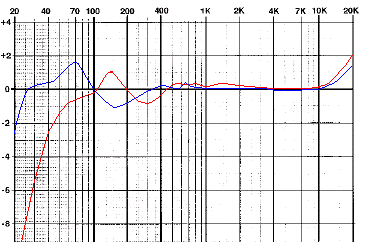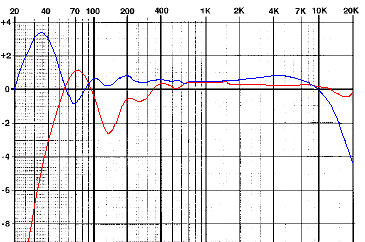In a parallel thread while discussing generational losses, I was surprised to hear that going from 15 ips to 30 ips speed, one gains high frequency fidelity but loses low frequency response. I was under the impression from my own experience in 1970s that the higher the speed, the better the response. But that did not extend to 30 ips. At least I don't think my consumer deck supported that???
Anyway, Myles pointed us to a very informative online article where someone had measured the record-playback frequency response of a number of tape decks: http://www.endino.com/graphs/
Indeed the graphs show the low frequency response drooping at 30 ips as this example of Otari MX-80 shows:

The 15 ips is in blue while the 30 ips is in red. The peak in 15 ips in blue is the "head bump." Another thing I did not know .
.
These variations which are +- 2 dB or so, would be clearly audible. And at any rate, what I hear is different than what another person would hear as this other example shows:

At the same 70 Hz, we are down 1 db whereas with the Otari, we were up 2 dB.
What I don't know and appreciate more data is how flat is the recording path itself? If one used the MRL test tapes, how would the response change? Would it have its own variations from deck A, combined with my playback machine, Deck B, where the sum is now even worse?
Here is another set of measurements of decks but this time comparing 7.5 to 15 ips. And it even has captured audio samples where the audible difference is quite clear!
http://www.toneboosters.com/reelproject2/
"From these simple examples it is obvious that analog tape recording can cause substantial differences in the audio signal spectrum, even at moderate signal levels that cause little saturation. Moreover, the employed recording unit seems to have a significant effect on the signal spectrum besides the tape speed, and hence a proper tape simulation algorithm should take these effects into account.
The two audio demos below clearly indicate the different character of the two recorders. A drumloop was recorded at the exact same (moderately high) level on both recorders at a tape speed of 7.5 IPS. The Teac A4300SX sounds quite bright, and handles the high signal level with relatively little distortion of the kick drum, while the opposite is true for the Revox A77."
The signature of both decks clearly comes through even though my laptop speakers. So we can digitize and hear the differences there.
The second page of that article talks about how the frequency response variation is level sensitive! http://www.toneboosters.com/reelproject3/

This is at very low speed of 3.75 ips. Someone has to tell me if it holds true at higher speeds too. If it does, it means that tape applies this dynamic EQ to everything it records. The frequency response of the system is modulated by the content itself. Wonder if this is euphonic (desirable) in nature or bad? Anyone know?
The article goes on to actually simulate these artifacts as to emulate the sound of the tape deck! If we can simulate the artifacts perhaps we can also reverse them.
Thinking out loud in the other thread, I mentioned that it would not be hard to make some corrections to uneven response of these machines. There is already analog equalization in the machine to achieve IEC, NAB, and in general flatter frequency response. So it is not like the system by itself is "EQ free."
The weapon of choice here would be a DSP and digital filtering since we can easily create curves with as much resolution and variations as we want to have as opposed to some kind of analog Parametric EQ where noise would be added and controls highly limited. And how knows what it does performance wise relative to distortion, bleeding filters and such.
The thought of applying digital to analog sources is beyond what some can bear. I understand that but that is defending a belief, lacking data. Until such time that we create such a correction, and perform formal listening test, we don't know what we are talking about. The theory of damning it right now is based on digital somehow destroying what is good about analog. I don't prescribe to that. I think the sound that we like in reel to reel is due to specific mastering that was performed for the medium, not because it is analog.
As long as we are prejudging the data we don't yet have , my intuition is that the variations in frequency response are far more audible than any superiority of analog over digital, should that theory be correct. So there, we are even.
, my intuition is that the variations in frequency response are far more audible than any superiority of analog over digital, should that theory be correct. So there, we are even. 
Anyway, Myles pointed us to a very informative online article where someone had measured the record-playback frequency response of a number of tape decks: http://www.endino.com/graphs/
Indeed the graphs show the low frequency response drooping at 30 ips as this example of Otari MX-80 shows:
The 15 ips is in blue while the 30 ips is in red. The peak in 15 ips in blue is the "head bump." Another thing I did not know
These variations which are +- 2 dB or so, would be clearly audible. And at any rate, what I hear is different than what another person would hear as this other example shows:
At the same 70 Hz, we are down 1 db whereas with the Otari, we were up 2 dB.
What I don't know and appreciate more data is how flat is the recording path itself? If one used the MRL test tapes, how would the response change? Would it have its own variations from deck A, combined with my playback machine, Deck B, where the sum is now even worse?
Here is another set of measurements of decks but this time comparing 7.5 to 15 ips. And it even has captured audio samples where the audible difference is quite clear!
http://www.toneboosters.com/reelproject2/
"From these simple examples it is obvious that analog tape recording can cause substantial differences in the audio signal spectrum, even at moderate signal levels that cause little saturation. Moreover, the employed recording unit seems to have a significant effect on the signal spectrum besides the tape speed, and hence a proper tape simulation algorithm should take these effects into account.
The two audio demos below clearly indicate the different character of the two recorders. A drumloop was recorded at the exact same (moderately high) level on both recorders at a tape speed of 7.5 IPS. The Teac A4300SX sounds quite bright, and handles the high signal level with relatively little distortion of the kick drum, while the opposite is true for the Revox A77."
The signature of both decks clearly comes through even though my laptop speakers. So we can digitize and hear the differences there.
The second page of that article talks about how the frequency response variation is level sensitive! http://www.toneboosters.com/reelproject3/

This is at very low speed of 3.75 ips. Someone has to tell me if it holds true at higher speeds too. If it does, it means that tape applies this dynamic EQ to everything it records. The frequency response of the system is modulated by the content itself. Wonder if this is euphonic (desirable) in nature or bad? Anyone know?
The article goes on to actually simulate these artifacts as to emulate the sound of the tape deck! If we can simulate the artifacts perhaps we can also reverse them.
Thinking out loud in the other thread, I mentioned that it would not be hard to make some corrections to uneven response of these machines. There is already analog equalization in the machine to achieve IEC, NAB, and in general flatter frequency response. So it is not like the system by itself is "EQ free."
The weapon of choice here would be a DSP and digital filtering since we can easily create curves with as much resolution and variations as we want to have as opposed to some kind of analog Parametric EQ where noise would be added and controls highly limited. And how knows what it does performance wise relative to distortion, bleeding filters and such.
The thought of applying digital to analog sources is beyond what some can bear. I understand that but that is defending a belief, lacking data. Until such time that we create such a correction, and perform formal listening test, we don't know what we are talking about. The theory of damning it right now is based on digital somehow destroying what is good about analog. I don't prescribe to that. I think the sound that we like in reel to reel is due to specific mastering that was performed for the medium, not because it is analog.
As long as we are prejudging the data we don't yet have

